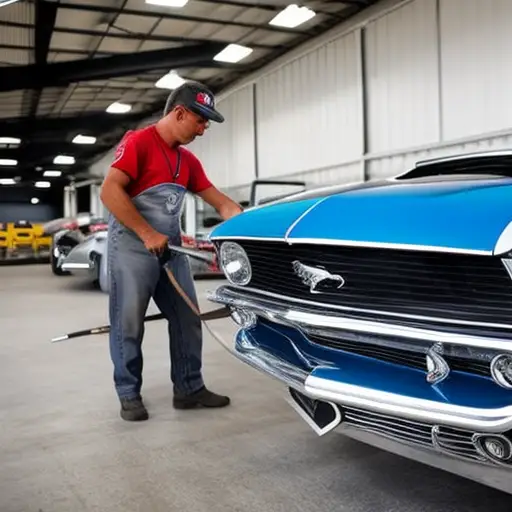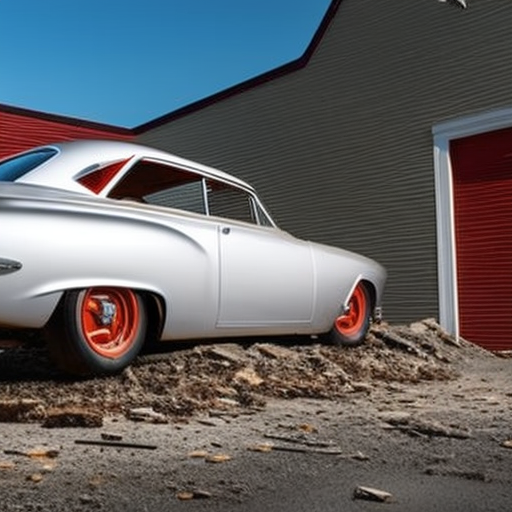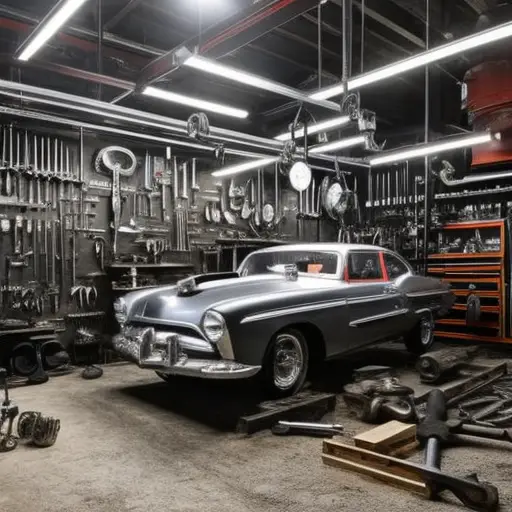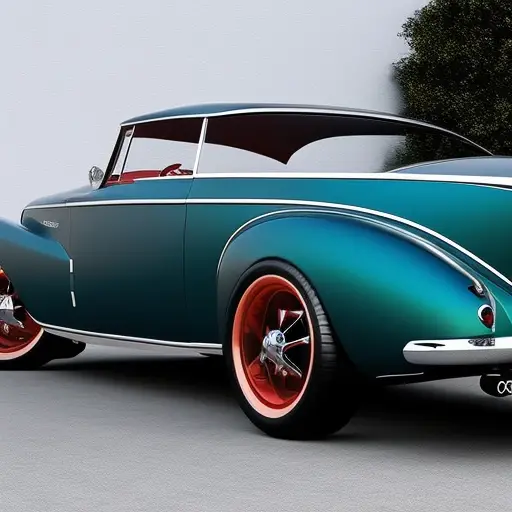The Role of Technology in Classic Car Restoration
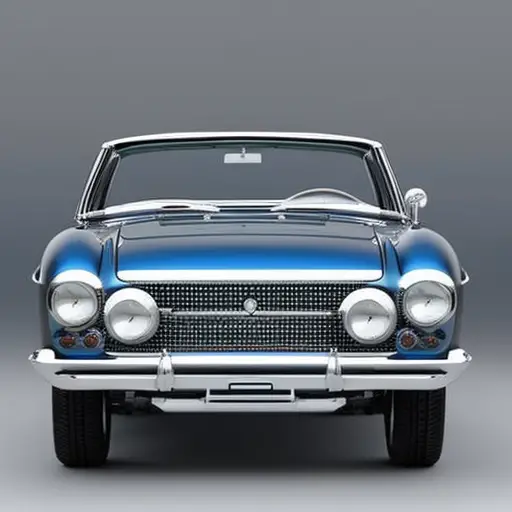
The timeless art of classic car restoration has been revitalized by the innovative integration of technology.
From the evolution of restoration techniques to the impact of 3D printing and advancements in computer-aided design, the marriage of tradition and technology has ushered in a new era of precision and efficiency.
This article explores the transformative role of technology in preserving the legacy of classic automobiles, revolutionizing the restoration process in ways previously unimaginable.
Evolution of Restoration Techniques
Periodically, classic car restoration techniques have evolved to incorporate modern technologies, revolutionizing the way vintage vehicles are restored to their former glory. The evolution of restoration techniques has been influenced by the integration of modern technology with traditional methods, resulting in enhanced restoration accuracy. Traditional techniques, such as metalworking, painting, and upholstery, have been refined and improved through the use of advanced machinery and computer-aided design (CAD) software. These modern tools enable restorers to achieve a level of precision and detail that was previously unattainable, ensuring that the finished restoration closely matches the original specifications of the vehicle.
Furthermore, the evolution of restoration techniques has also been driven by the development of new materials and processes. For instance, the use of 3D printing technology allows for the recreation of rare or obsolete parts with remarkable accuracy, preserving the authenticity of the vehicle. Additionally, advancements in surface treatment and coating technologies contribute to prolonging the longevity of restored components, ensuring that classic cars maintain their pristine condition for years to come.
Impact of 3D Printing
The impact of 3D printing in classic car restoration is profound, offering advancements in part replication, the ability to create customized restoration components, and the preservation of vintage aesthetics.
With 3D printing technology, classic car enthusiasts and restoration experts can precisely replicate rare and hard-to-find parts, ensuring the authenticity and historical accuracy of the restoration process.
Moreover, it allows for the creation of unique, custom components that can enhance the performance and aesthetics of classic cars while maintaining their original charm.
Advancing Part Replication
Advancements in 3D printing technology have revolutionized the process of replicating classic car parts, offering unprecedented precision and customization opportunities. This technology enables the creation of parts with material authenticity and replication precision, ensuring that the replacement components closely match the original ones. Moreover, 3D printing facilitates cost efficiency and time savings, as it eliminates the need for specialized tooling and extensive manual labor typically associated with traditional manufacturing methods. Below is a table outlining the key advantages of 3D printing in classic car part replication:
| Advantages | Description |
|---|---|
| Material Authenticity | Ability to replicate parts using a wide range of materials, matching the original specs. |
| Replication Precision | Precision in reproducing intricate details and dimensions, ensuring part compatibility. |
| Cost Efficiency | Reduction in production costs through minimized material waste and efficient processes. |
| Time Savings | Streamlined production timelines, enabling quicker restoration of classic vehicles. |
Customized Restoration Components
The integration of 3D printing technology has significantly enhanced the ability to create customized restoration components for classic cars, allowing for precise replication and material authenticity. This technological advancement has revolutionized the restoration process by enabling customized fabrication of rare or discontinued parts that are essential for maintaining vintage craftsmanship.
3D printing offers the flexibility to produce one-of-a-kind components tailored to the exact specifications of classic car models, ensuring a seamless fit and authentic aesthetic. This level of customization goes beyond what traditional manufacturing methods can achieve, providing classic car enthusiasts and restoration specialists with a means to preserve the historical accuracy and integrity of vintage vehicles.
The impact of 3D printing on customized restoration components is pivotal in upholding the legacy and heritage of classic automobiles.
Preservation of Vintage Aesthetics
An increasingly crucial factor in preserving the vintage aesthetics of classic cars is the impact of 3D printing on restoration. This technology has allowed for the creation of highly accurate and customized components, ensuring the exact replication and material authenticity necessary for maintaining the historical integrity of these vehicles.
This technology has been instrumental in preserving vintage design elements and ensuring craftsmanship preservation in classic car restoration. By utilizing 3D printing, restorers can recreate intricate and hard-to-find parts with remarkable precision, thereby upholding the original aesthetics and design of vintage vehicles. This method not only maintains the visual appeal but also ensures that the historical significance and authenticity of classic cars are retained.
Moreover, 3D printing enables the production of bespoke components that are tailored to specific restoration requirements, further enhancing the preservation of vintage aesthetics.
Transitioning into advancements in computer-aided design, new possibilities for precision and efficiency in classic car restoration emerge.
Advancements in Computer-Aided Design
Utilizing advanced computer-aided design techniques has significantly enhanced the precision and efficiency of classic car restoration processes.
Digital modeling allows for precise replication of vintage car parts, ensuring an exact fit and finish. Precision measurement tools integrated with CAD software enable restoration specialists to capture accurate dimensions of intricate components, facilitating seamless restoration work.
Virtual prototyping enables the creation of 3D models of the vintage car, allowing restoration experts to visualize and analyze the design before physically implementing changes. Material simulation within CAD software aids in selecting the most suitable materials for restoration, ensuring durability while maintaining authenticity.
These advancements in computer-aided design have revolutionized the classic car restoration industry, enabling meticulous restoration work with unparalleled accuracy and efficiency.
With the precision and efficiency facilitated by advanced computer-aided design techniques, the next crucial aspect to explore is ‘digital imaging and documentation’ in the context of classic car restoration.
Digital Imaging and Documentation
Digital imaging and documentation play a crucial role in classic car restoration. They preserve original design details, enhance restoration accuracy, and facilitate remote collaboration.
Through high-resolution imaging, restorers can capture intricate details of vintage cars. This ensures that the original design elements are accurately preserved during the restoration process.
Additionally, digital documentation allows for seamless collaboration between experts and enthusiasts. Regardless of geographical location, they can work together to create a more comprehensive and accurate restoration process.
Preserving Original Design Details
Preserving original design details in classic car restoration involves employing digital imaging and documentation to capture and safeguard the car’s authentic features. This process ensures that the original material and vintage craftsmanship of the vehicle are accurately preserved for future reference and restoration efforts.
The use of advanced digital imaging techniques allows for the creation of high-resolution scans and detailed documentation of every intricate design element, from the unique curves of the bodywork to the specific characteristics of the interior upholstery. By utilizing digital imaging and documentation, restoration specialists can effectively capture the essence of the classic car’s original design, ensuring that its historical and cultural significance is faithfully preserved for generations to come.
- High-resolution digital scanning
- Detailed documentation of design elements
- Preservation of historical and cultural significance
Enhancing Restoration Accuracy
The implementation of advanced digital imaging and documentation techniques significantly enhances the accuracy of classic car restoration efforts.
Historical accuracy and precision are paramount in the restoration of classic cars. With the fusion of artisan craftsmanship and modern technology, digital imaging allows for the precise documentation and replication of original design details.
High-resolution scanning and 3D modeling capture the intricacies of vintage car components, ensuring that the restoration process stays true to the vehicle’s historical authenticity. Moreover, digital documentation enables restorers to create a comprehensive record of the car’s original state, facilitating the preservation of its unique characteristics.
Facilitating Remote Collaboration
Facilitating remote collaboration in classic car restoration through digital imaging and documentation allows professionals to work together seamlessly regardless of geographical constraints. This is achieved through virtual consultations and remote project management, enabling experts to communicate and coordinate effectively. Digital collaboration tools and online restoration resources further enhance this process, providing a platform for sharing project updates, reference materials, and best practices. These technologies not only streamline the restoration process but also facilitate knowledge sharing and skill development within the classic car restoration community. As technology continues to advance, the ability to collaborate remotely will become increasingly integral to the restoration of classic cars, ensuring that expertise and resources can be leveraged irrespective of physical location.
Transitioning into the subsequent section about ‘precision machining and replication’, the integration of technology in classic car restoration extends to the realm of precision manufacturing and replication.
Precision Machining and Replication
Precision machining and replication are essential processes in classic car restoration. These processes often require meticulous attention to detail and expertise. Computer Numerical Control (CNC) machining has revolutionized the restoration of classic cars. It allows for the precise replication of intricate metal parts that are no longer in production. This advanced technology enables restorers to recreate components with a level of accuracy that was previously unattainable. It ensures that the restored vehicle maintains its authenticity and historical value.
CNC machining involves the use of computer-aided design (CAD) software. This software creates a digital model of the desired component. The digital model is then translated into instructions for the CNC machine. The machine produces the part from a solid block of metal. This process allows for the replication of even the most complex and unique parts, preserving the originality of classic cars.
Whether it’s reproducing a vintage engine component or a rare trim piece, CNC machining plays a pivotal role in ensuring that classic cars are restored to their original specifications. It maintains the integrity and historical significance of these automotive treasures.
Accessibility and Efficiency
Utilizing advanced technology, restorers frequently rely on CNC machining to enhance the accessibility and efficiency of classic car restoration processes. CNC machining allows for precise and automated manufacturing of replacement parts, contributing to improved accessibility by ensuring a consistent supply of components for classic cars. Moreover, it streamlines processes by reducing manual labor and human error, thereby increasing the overall efficiency of restoration projects. This technology facilitates the restoration of rare and discontinued parts, making them more accessible to enthusiasts and professionals alike.
-
CNC machining enables the replication of intricate and complex components with unparalleled accuracy, ensuring improved accessibility to parts that are otherwise challenging to source.
-
The automation and precision offered by CNC machining streamline restoration processes, leading to increased efficiency and reduced turnaround times for classic car restoration projects.
-
By utilizing CNC machining, restorers can produce custom-made parts tailored to specific requirements, enhancing the accessibility of unique components and contributing to the streamlined restoration of classic cars.
Frequently Asked Questions
What Are the Environmental Impacts of Using Advanced Technology in Classic Car Restoration?
The use of advanced technology in classic car restoration can have environmental impacts. It is important to consider sustainable practices to minimize the carbon footprint and waste generation associated with the restoration process.
How Has the Use of Digital Imaging and Documentation Improved the Accuracy of Restoration Projects?
The use of digital imaging and documentation has significantly improved restoration accuracy by providing precise measurements and reference points. This technology allows for meticulous documentation and analysis, resulting in more accurate and authentic restoration projects.
Are There Any Ethical Considerations When Using 3D Printing for Replicating Classic Car Parts?
Ethical considerations are paramount when using 3D printing for replicating classic car parts. It’s crucial to ensure that intellectual property rights are respected, and the reproduction doesn’t devalue or compromise the authenticity of the original classic cars.
What Are the Limitations of Computer-Aided Design in Classic Car Restoration?
Computer-aided design offers precise tools for classic car restoration, enhancing restoration accuracy. However, it has limitations in replicating traditional craftsmanship. Ethical considerations in 3D printing and cost accessibility also impact its use.
How Has the Accessibility of Advanced Technology Affected the Cost of Classic Car Restoration?
The accessibility of advanced technology has significantly impacted the cost of classic car restoration. With the availability of modern tools and equipment, restoration processes have become more efficient, leading to potential cost savings for enthusiasts and professionals alike.
Conclusion
In conclusion, the integration of technology in classic car restoration has revolutionized the process, enabling more precise and efficient restoration techniques.
From the impact of 3D printing to advancements in computer-aided design and precision machining, technology has significantly improved accessibility and efficiency in classic car restoration.
The marriage of technology and classic car restoration is like a symphony, harmonizing the traditional art of restoration with the modern precision of technology.

